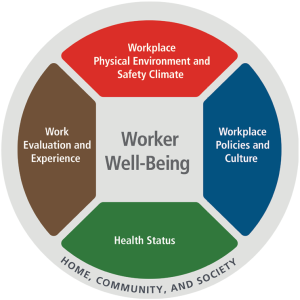
Terms of Use
The National Institute for Occupational Safety and Health Worker Well-Being Questionnaire (NIOSH WellBQ) is a questionnaire about your well-being. It will ask you questions about your job, your workplace, your health, and your life outside of work.
The information obtained from the NIOSH WellBQ is intended to help employers, employees, researchers, and policymakers understand the well-being of workers and identify opportunities to improve worker well-being.
You are being invited to take the NIOSH WellBQ. It will take about 15-20 minutes. Taking part in this questionnaire is voluntary. You may refuse to participate. You can stop at any time.
Several steps are taken to make sure that the answers you provide are anonymous. For example, the questionnaire does not ask for your name. While IP address (i.e., the location and number associated with your computer) is collected in the background, it will never be connected to your data. Further, the answers you give will be combined with the answers from many other people who are taking the questionnaire.
If you decide to take part in this questionnaire, you can choose how your data are used. You can choose to have your answers shared with your employer to help your employer understand the well-being of workers in your organization and enable steps to improve the well-being of the workforce. If you choose to do that, your answers will not be linked to information (e.g. age, race) that might identify you.
You can also choose to have your answers combined in a national database (called the HERO Worker Well-Being Clearinghouse, Powered by the NIOSH WellBQ) that will be used to help researchers, policymakers, and health professionals understand and improve the well-being of employees in the U.S. There is no cost to you to take the questionnaire. There is no guarantee of direct benefits to you if you take the questionnaire. Some people may find this questionnaire interesting. We encourage you to answer all of the questions to provide a complete picture of your job, health, and other issues related to your well-being. However, if you find that some of the questions make you uneasy, you can choose to not answer them. You can also stop answering questions at any time. If you want to talk to someone about questions or concerns later, please email WellBQClearinghouse@hero-health.org.
For more information, please see our HERO Worker Well-Being Clearinghouse background information and/or our frequently asked questions. You can also email your questions to WellBQClearinghouse@hero-health.org.
Background Information
 The Health Enhancement Research Organization (HERO) has partnered with National Institute for Occupational Safety and Health (NIOSH) to create the HERO Worker Well-Being Clearinghouse – Powered by the NIOSH WellBQ (HERO Worker Well-Being Clearinghouse), an open-source database that houses de-identified data arising from use of the English and Spanish versions of the NIOSH Worker Well-Being Questionnaire (NIOSH WellBQ). HERO has made the NIOSH WellBQ available in an online survey platform to enable organizations to easily administer it to employees. Organizations will receive a de-identified, summary report of the data collected from their unique questionnaire link. De-identified data will be imported into the HERO Worker Well-Being Clearinghouse for public use by individuals interested in conducting research on worker well-being.
The Health Enhancement Research Organization (HERO) has partnered with National Institute for Occupational Safety and Health (NIOSH) to create the HERO Worker Well-Being Clearinghouse – Powered by the NIOSH WellBQ (HERO Worker Well-Being Clearinghouse), an open-source database that houses de-identified data arising from use of the English and Spanish versions of the NIOSH Worker Well-Being Questionnaire (NIOSH WellBQ). HERO has made the NIOSH WellBQ available in an online survey platform to enable organizations to easily administer it to employees. Organizations will receive a de-identified, summary report of the data collected from their unique questionnaire link. De-identified data will be imported into the HERO Worker Well-Being Clearinghouse for public use by individuals interested in conducting research on worker well-being.
What is the NIOSH WellBQ?
 The NIOSH WellBQ provides an integrated assessment of worker well-being across multiple spheres, including individuals’ quality of working life, circumstances outside of work, and physical and mental health status.1
The NIOSH WellBQ provides an integrated assessment of worker well-being across multiple spheres, including individuals’ quality of working life, circumstances outside of work, and physical and mental health status.1
The questionnaire measures “worker” well-being as a holistic construct rather than simply “workplace” or “work-related” well-being. The NIOSH WellBQ is intended to help researchers, employers, workers, practitioners, and policymakers understand the well-being of workers and target interventions to improve worker well-being, among other applications.1
The NIOSH WellBQ was created by NIOSH and researchers at the RAND Corporation with funding from NIOSH. The design and content of the NIOSH WellBQ were guided by a new conceptual framework that identifies five domains of worker well-being,2 including:
- Work Evaluation and Experience
- Workplace Policies and Culture
- Workplace Physical Environment and Safety Climate
- Health Status
- Home, Community, and Society
The Development of the NIOSH WellBQ
This framework was derived from an in-depth, multi-disciplinary literature review of well-being theories, research, and measurement tools by NIOSH and the RAND Corporation. The items in the questionnaire were selected based on their relevance to the five domains of worker well-being. Most of the items are adopted from existing instruments. Psychometric analyses were performed on data from 975 respondents to finalize items and optimize the NIOSH WellBQ’s psychometric properties. The final questionnaire consists of 16 scales, 5 indices, and 31 single items across the 5 domains. It is followed by employment and demographic questions that are optional; however, they will be critical to helping your organization understand the well-being of different populations in the organization. The instrument demonstrated adequate reliability and validity.3
How can my organization participate?
 Organizations that plan to use the NIOSH WellBQ with their employees will need to complete the registration form on the HERO Worker Well-Being Clearinghouse webpage or email WellBQClearinghouse@hero-health.org. This needs to be done to generate the unique organization link that can be sent out to the organization’s employees. The link provided will remain active, allowing access to the questionnaire for 30 days, unless a different timeline is requested by the organization. Organizations will receive a summary report of the results, as well as a summary report of the demographic and employment questions. The report will be provided in such a way that individuals cannot be identified.
Organizations that plan to use the NIOSH WellBQ with their employees will need to complete the registration form on the HERO Worker Well-Being Clearinghouse webpage or email WellBQClearinghouse@hero-health.org. This needs to be done to generate the unique organization link that can be sent out to the organization’s employees. The link provided will remain active, allowing access to the questionnaire for 30 days, unless a different timeline is requested by the organization. Organizations will receive a summary report of the results, as well as a summary report of the demographic and employment questions. The report will be provided in such a way that individuals cannot be identified.
- Sample NIOSH WellBQ Summary Results Report (This data is from a random sample of completers)
- Sample Demographic and Employment Questions Summary Report (This data is from a different random sample of completers than the summary results report)
How can an organization use the data collected from their workforce?
 The information gained from the questionnaire can help employers evaluate the status of their employees’ well-being. Those that choose to have de-identified data (excluding injury, demographic, and employment information) can combine the data with organizational Scorecard data to inform an organization’s health and well-being strategic plan. Follow-up assessment can then help to evaluate the effectiveness of the interventions.
The information gained from the questionnaire can help employers evaluate the status of their employees’ well-being. Those that choose to have de-identified data (excluding injury, demographic, and employment information) can combine the data with organizational Scorecard data to inform an organization’s health and well-being strategic plan. Follow-up assessment can then help to evaluate the effectiveness of the interventions.
How can researchers use the data from the HERO Worker Well-Being Clearinghouse?
De-identified data imported into the HERO Worker Well-Being Clearinghouse can be used by practitioners, researchers, policymakers, etc. to analyze trends in worker well-being, target interventions and develop programs/services to improve worker well-being, identify ways to improve policies affecting well-being, among other applications. To gain access to the HERO Worker Well-Being Clearinghouse, one must complete the data access form.
- NIOSH [2021]. NIOSH worker well-being questionnaire (WellBQ). By Chari R, Chang CC, Sauter SL, Petrun Sayers EL, Huang W, Fisher GG. Cincinnati, OH: U.S. Department of Health and Human Services, Centers for Disease Control and Prevention, National Institute for Occupational Safety and Health, DHHS (NIOSH) Publication No. 2021-110 (revised 5/2021), https://doi.org/10.26616/NIOSHPUB2021110revised52021
- Chari, Ramya PhD; Chang, Chia-Chia MPH, MBA; Sauter, Steven L. PhD; Petrun Sayers, Elizabeth L. PhD; Cerully, Jennifer L. PhD; Schulte, Paul PhD; Schill, Anita L. PhD; Uscher-Pines, Lori PhD. Expanding the Paradigm of Occupational Safety and Health: A New Framework for Worker Well-Being. Journal of Occupational and Environmental Medicine 60(7):p 589-593, July 2018. | DOI: 10.1097/JOM.0000000000001330
- Chari R, Sauter SL, Petrun Sayers EL, Huang W, Fisher GG, Chang CC. Development of the National Institute for Occupational Safety and Health Worker Well-Being Questionnaire. J Occup Environ Med. 2022 Aug 1;64(8):707-717. doi: 10.1097/JOM.0000000000002585. Epub 2022 Jun 9. PMID: 35673249; PMCID: PMC9377498.
Frequently Asked Questions
Respondent FAQs
No. However, once you begin the questionnaire, it will only be saved in the browser in which you started.
No. Your participation is fully voluntary, and you can stop any time. Your answers will be helpful to your organization in assessing how well their current policies, practices, and programs are doing to support your well-being. Your answers will help your organization identify opportunities for improvement.
Please complete the questionnaire in its entirety to provide a complete picture of your job, health, and well-being. While you may choose to skip a question, we encourage you to answer all of the questions. There are no right or wrong answers. You should respond honestly based upon your beliefs and feelings. Some questions might not apply to your situation. In these cases, you can choose “Does not apply” if it is one of the answer choices.
We ask employment and demographic questions to provide valuable insights into the different working populations. However, these questions are optional. Only a summary report will be provided to your organization.
The questionnaire has 68 questions, and it will take most participants about 20 minutes. It is followed by 6 employment and 10 demographic questions. Like the other questions, these are optional. Your answers will help your organization understand the well-being of different people in the organization.
You can save the questionnaire and continue later if you are not able to complete it. However, we encourage you to complete it in one session.
The design and content were guided by a conceptual framework that identifies the five domains of worker well-being. This framework was derived from an in-depth, literature review of well-being theories, research, and measurement tools with assistance from a panel of experts in occupational safety, health, and well-being. The items were selected based on their relevance to the five domains of worker well-being. Most of the items are adopted from existing, well-established instruments. After development, the questionnaire was pilot tested with U.S. workers across many industries and occupations.
A summary of the overall results will be shared with your organization. This means no personal identifying information will be shared. We recommend that the organization use the results to develop or improve policies, programs, or practices that advance well-being. Your information will help your organization better understand and improve the overall well-being of the workforce.
Some people may find this questionnaire interesting. Completing the questionnaire will help provide a clearer picture of important aspects of well-being of the workforce. We recommend that organizations use the results to improve their well-being initiatives in an attempt to support all employees.
Yes. No names, user IDs, or other personally identifiable information will be provided to your organization.
Organization FAQs
We recommend that organizations keep the survey open for no more than 30 days. We also encourage organizations to send reminders throughout this time to employees to take the survey. HERO has created email templates that can be used or adapted to send out your unique survey link, as well as remind employees to take the survey before the end date.
The best practice for sharing results depends on industry type, organization size, and percent remote workforce. Here are some successful methods that our pilot organizations used.
- Smaller organization: Share summary findings and highlight top 5 areas of strength and top 5 areas of opportunity, allowing employees to reflect. Follow-up with a brainstorming session on the areas of opportunity.
- Mid-size organization: Share summary findings at all-employee meeting and have team supervisors lead more guided discussions in department meetings.
- Large organization: Administer separate survey links for each department. Compile results and provide a company-wide report, along with department specific reports to each department lead. Department leads then share results with their department and set goals together.
Organizations are encouraged to think through how to share and use the results before administering the survey.
Organizations can identify opportunities for improvement based on results and set SMART goals around each area of opportunity. When doing so, it is important to include employee representatives and consider who is responsible for carrying out the actions that will enable to goal to be accomplished, what is being measured to assess progress, what stakeholders need to be involved, and how it contributes to key business outcomes.
If you have access to the raw data, you may find that for a given question there are only a few individuals (or even only one individual) that selected a certain response option. While this may seem as if it is an outlier, it should not be approached this way. You should try to take all employee responses into consideration.
Raw data is available for a fee. Please contact wellbqclearinghouse@hero-health.org if you are interested in obtaining your organizations de-identified data.
Raw data will include responses to the NIOSH WellBQ questions and scale/index scores. Injury-related, health behavior, health outcome, demographic, and employment questions will only be included if there are 30 responses for each response option. This is to protect anonymity of respondents. You can check to see if this threshold has been met for various items for your organization before purchasing the raw data.
Yes, additional analyses can be performed for a fee. Please reach out wellbqclearinghouse@hero-health.org to discuss your organization’s analysis needs. Note, if you want descriptives (mean, median, range) on specific demographic or employment categories, there must be at least 10 responses in a category to run.
Benchmarking analysis is a systematic process used by organizations to compare their own practices, processes, or performance metrics with those of other similar organizations, industry standards, or best-in-class companies. Benchmarking data will be made available for various employment and demographic categories once enough data have been collected.
- Industry: 10 unique organizations from a specific industry
- Size: 10 unique organizations of a specific size category
- Demographics + employment questions: All questions must have 30 responses for each response option
- Injury-related questions: 30 responses options for each response option
- Health outcomes questions: 30 responses for each health outcome
- Health behavior questions (alcohol consumption, risky drinking, and tobacco use): 30 responses for each health behavior
- For the alcohol consumption question, scores will be used for the threshold rather than the write in answers. For example, for males, there need to be 30 responses with a code of 1 (14 drinks or more per week) and 30 responses with a code of 0 (fewer than 14 drinks per week)


